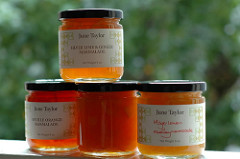The Other Lady Marmalade

Photo by Melissa Schneider.
Watch an artisan at work and you get a new appreciation for her products and her prices. That thought came to me as I attended a marmalade class with June Taylor. The clean, vibrant flavors of Taylor's jams, marmalades, and conserves inspire foodie zealotry, but I don't often buy from her stall at the Ferry Plaza Farmer's Market. The prices fall just out of my range for impulse buys.
Now I think they're bargains.
Taylor's products share nothing but a name with commercial versions; we students tasted some store-bought marmalades for comparison at the end of the class and they failed miserably next to her deeply colored jars of hand-crafted jellylike goodness. Traditional British practices inform her techniques, even at volumes much larger than her spiritual predecessors in pre-industrial England. She selects seasonal fruit carefully and works in small batches with "one and a half" other people. Her biggest workhorse pot is roughly twice the size of my normal stockpot (Shuna wisely noted that the small scale ensures that if you mess up a batch, you haven't lost too much sellable product).
She walked us through the simple process. Prep the fruit by segmenting the citrus and chopping the peel, reserving the membranes and seeds for pectin (Taylor doesn't use any commercial pectin). Boil the fruit and water with a jelly bag of the pectin-rich material. Squeeze that pectin from the bag into the liquid, add sugar to taste, and cook until the solution reaches 228°. Taylor tries to preserve as much flavor as possible, even if it means accepting a looser set. Pour the marmalade into jars, seal, let it cool, and store until ready to eat. We went from globes of citrus to a dozen small jars in about four hours.
It sounds straightforward, and it is. But when you think of Taylor and her small staff segmenting the fruit, chopping the peels, and manually squeezing pectin out of a jelly bag to produce the cases of jars we saw cooling on a nearby rack, it boggles the mind. She offered tips as she went, fueled by her philosophies and experience: Sterilize the jars by leaving in a 250° oven for 10 minutes or more instead of boiling them in a water bath and drying them, use minimal amounts of sugar to prevent an overly sweet product, work with very tart fruit to keep the flavor bright above the sugar (her classic Seville orange marmalade sends a jolt of acidity up your spine).
The experience that guides her hand can be frustrating to a student. Taylor measures half her ingredients by weight and the other half by volume, which makes her proportions tricky to figure out. She knows how mixtures are supposed to look, and can navigate a batch of marmalade through intuition. For cooks like me who have made one batch of marmalade in our lives, I worry about going solo.
Practice, practice, practice, I suppose. I'll make some batches soon so that I solidify the technique a bit more in my mind. Melissa, as always, is supportive.
- Ginger Peach Preserves Recipe
I am happy to be a "canbassador" for SweetPreservation.com, a community site of the Northwest cherry growers and soft fruit growers of Washington state. They sent me a big box of juicy, sweet, ripe Country Sweet peaches which I agreed to preserve,...
- Tea Together Jams: Favorite Things
Some people don't like receiving product samples, but I don't mind. Of course I'm pretty fussy about what I'll consider and not everything I try is wonderful. But I never know what unexpected taste will inspire me. Over the past few years...
- Unexpected Results: Apricot Jam
I have made apricot jam every June for at least the past 10 years and I’ve never had it turn out like this. It seems to taste okay, but it sure is ugly. It started out so well, too. The apricots were some of the nicest I’ve ever used – perfectly...
- Jelly On The Fast-track
Black Currant Jelly with Biscuits I grew up watching my Grammy slave over a steaming hot stove each summer & fall, 'putting up' tomato sauce, pickles, pickled beets, jelly...pretty much anything that came out of the garden. I remember running...
- Cooking For Two
We are on a temporary hiatus from dinner parties, catching up with various things. But I view it as a chance to practice some things I have been interested in, as well as try out some recipes from a cookbook I'm reviewing for my food writing class....
